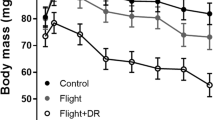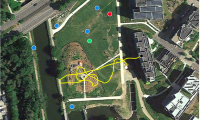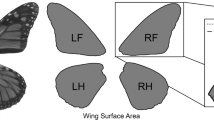Abstract
Realized fitness in a fluctuating environment depends on the capacity of an ectothermic organism to function at different temperatures. Flying heliotherms like butterflies use flight for almost all activities like mate location, foraging and host plant searching and oviposition. Several studies tested the importance of ambient temperature, thermoregulation and butterfly activity. Here, we test the influence of variation in flight morphology in interaction with differences in body temperature on locomotor performance, which has not been thoroughly examined so far. Take-off free flight performance was tested at two different body temperatures in males and females of the speckled wood butterfly Pararge aegeria. We found that both males and females accelerated faster at the optimal body temperature compared to the suboptimal one. The multivariate analyses showed significant sex-specific contributions of flight morphology, body temperature treatment and feeding load to explain variation in acceleration performance. Female and male butterflies with a large relative thorax (i.e. flight muscle investment) mass and large, slender wings (i.e. aspect ratio) accelerated fast at optimal temperature. However, high aspect ratio individuals accelerated slowly at suboptimal temperature. Females of low body mass accelerated fast at optimal, but slowly at suboptimal body temperature. In males, there was an interaction effect between body and relative thorax mass: light males with high relative thorax mass had higher performance than males with a low relative thorax mass. In addition, relative distance to the centre of forewing area was positively related to acceleration at both temperatures in males. Males and females with higher feeding loads had lower levels of acceleration. Finally, males that were able to accelerate fast under both temperatures, had a highly significantly heavier relative thorax, lower body and abdomen mass. More generally, this study shows that the significance of butterfly flight morphology in terms of flight performance is at least partially dependent on body temperature.





Similar content being viewed by others
References
Berrigan D (1991) Lift production in the flesh fly, Neobelleria=Sarcophaga) bullataf Parker. Funct Ecol 5:448–456
Berwaerts K, Van Dyck H, Vints E, Matthysen E (2001) Effect of manipulated wing characteristics and basking posture on thermal properties of the butterfly Pararge aegeria (L.). J Zool 255:261–267
Berwaerts K, Van Dyck H, Aerts P (2002) Does flight morphology relate to flight performance? An experimental test with the butterfly Pararge aegeria. Funct Ecol 16:484–491
Betts CR, Wootton RJ (1988) Wing shape and flight behaviour in butterflies (Lepidoptera: Papilionoidea and Hesperioidea): a preliminary analysis. J Exp Biol 138:271–288
Biewener AA, Full RJ (1990) Force platform and kinematic analysis. In: Biewener AA (ed) Biomechanics—structures and systems: a practical approach. Oxford University Press, Oxford, pp 45–73
Bishop JA, Armbruster WS (1999) Thermoregulatory abilities of Alaskan bees: effects of size, phylogeny and ecology. Funct Ecol 13:711–724
Bonser RHC, Rayner JMV (1996) Measuring leg thrust forces in the common starling. J Exp Biol 199:435–439
Clench HK (1966) Behavioral thermoregulation in butterflies. Ecology 47:1021–1034
Coelho JR (1997) Sexual size dimorphism and flight behavior in cicada killers, Sphecius speciosus. Oikos 79:371–375
Crompton B, Thomason JC, McLachlan A (2003) Mating in a viscous universe: the race is to the agile, not to the swift. Proc R Soc Lond Ser B 270:1991–1995
Dennis RLH (1993) Butterflies and climate change. Manchester University Press, Manchester
Dennis RLH, Shreeve TG (1989) Butterfly wing morphology variation in the British Isles: the influence of climate, behavioural posture and the hostplant-habitat. Biol J Linn Soc 38:323–348
Douwes P (1976) Activity in Heodes virgaureae (Lep., Lycaenidae) in relation to air temperature, solar radiation, and time of day. Oecologia 22:287–298
Dreisig H (1995) Thermoregulation and flight activity in territorial male graylings, Hipparchia semele (Satyridae), and large skippers, Ochlodes venata (Hesperiidae). Oecologia 101:169–176
Dudley R (2000) The biomechanics of insect flight: form, function, evolution. Princeton University Press, Princeton, N.J.
Esch H (1976) Body temperature and flight performance of honey bees in a servo-mechanically controlled wind tunnel. J Comp Physiol 190:265–277
Fischer H, Kutsch W (2000) Relationships between body mass, motor output and flight variables during free flight of juvenile and mature adult locations, Schistocerca gregaria. J Exp Biol 203:2723–2735
Forsman A (1999) Temperature influence on escape behaviour in two species of pygmy grasshoppers. Ecoscience 6:35–40
Gilchrist GW (1995) Specialists and generalists in changing environments: 1. Fitness landscapes of thermal sensitivity. Am Nat 146:252–270
Gilchrist GW (1996) A quantitative genetic analysis of thermal sensitivity in the locomotor performance curve of Aphidius ervi. Evolution 50:1560–1572
Hedenström A, Ellington CP, Wolf T (2001) Wing wear, aerodynamics and flight energetics in bumblebees (Bombus terrestris): an experimental study. Funct Ecol 15:417–422
Heinrich B (1975) Thermoregulation in bumblebees. II. Energetics of warm-up and free flight. J Comp Physiol 166:155–166
Heinrich B (1986) Thermoregulation and flight activity of a satyrine, Coenonympha inornata (Lepidoptera: Satyridae). Ecology 67:593–597
Huey RB, Kingsolver JG (1989) Evolution of thermal sensitivity of ectotherm performance. Trends Ecol Evol 4:131–135
Isaacs R, Byrne DN (1998) Aerial distribution, flight behaviour and eggload: their inter-relationship during dispersal by the sweetpotato whitefly. J Anim Ecol 67:741–750
James FC, McCulloch CE (1990) Multivariate analysis in ecology and systematics: panacea or pandora’s box? Annu Rev Ecol Syst 21:129–166
Karlsson B (1994) Feeding habits and change of body composition with age in three nymphalid butterfly species. Oikos 69:224–230
Kemp DJ, Wiklund C (2001) Fighting without weaponry: a review of male-male contest competition in butterflies. Behav Ecol Sociobiol 49:429–442
Kemp DJ, Wiklund C (2004) Residency effects in animal contests. Proc R Soc Lond Ser B (in press)
Kingsolver JG (1985) Thermoregulatory significance of wing melanization in Pieris butterflies (Lepidoptera: Pieridae): physics, posture, and pattern. Oecologia 66:546–553
Kingsolver JG (1999) Experimental analyses of wing size, flight, and survival in the western white butterfly. Evolution 53:1479–1490
Kullberg C, Fransson T, Jakobsson S (1996) Impaired predator evasion in fat blackcaps (Sylvia atricapilla). Proc R Soc Lond Ser B 263:1671–1675
Kullberg C, Jakobsson S, Fransson T (1998) Predator-induced take-off strategy in great tits (Parus major). Proc R Soc Lond Ser B 265:1659–1664
Lee SJ, Witter MS, Cuthill IC, Goldsmith AR (1996) Reduction in escape performance as a cost of reproduction in gravid starlings, Sturnus vulgaris. Proc R Soc Lond Ser B 263:619–624
Lehmann F-O (1999) Ambient temperature affects free-flight performance in the fruit fly Drosophila melanogaster. J Comp Physiol B 169:165–171
Lessells CM, Boag PT (1987) Unrepeatable repeatabilities: a common mistake. Auk 104:116–121
Lind J, Fransson T, Jakobsson S, Kullberg C (1999) Reduced take-off ability in robins (Erithacus rubecula) due to migratory fuel load. Behav Ecol Sociobiol 46:65–70
Littell RC, Milliken GA, Stroup WW, Wolfinger RD (1996) SAS system for mixed models. SAS Institute, Cary, N.C.
Marden JH (1987) Maximum lift production during takeoff in flying animals. J Exp Biol 130:235–258
Marden JH (1989) Effects of load-lifting constraints on the mating system of a dance fly. Ecology 70:496–502
Marden JH (2000) Variability in the size, composition, and function of insect flight muscles. Annu Rev Physiol 62:157–178
Marden JH, Chai P (1991) Aerial predation and butterfly design: how palatability, mimicry, and the need for evasive flight constrain mass allocation. Am Nat 138:15–36
Neter J, Kutner MH, Nachtsheim C, Wasserman W (1996) Applied linear statistical models. Irwin, Chicago, Ill.
Norberg UM (1995) How a long tail and changes in mass and wing shape affect the cost for flight in animals. Funct Ecol 9:48–54
Nudds RL, Bryant DM (2000) The energetic cost of short flights in birds. J Exp Biol 203:1561–1572
Nylin S, Wickman P-O, Wiklund C (1995) Life-cycle regulation and life history plasticity in the speckled wood butterfly: Are reaction norms predictable? Biol J Linn Soc 55:143–157
Optimas (1999) Optimas 6.51. User’s guide and technical reference, 9th edn. Optimas, Washington, D.C.
Pivnick KA, McNeil JN (1986) Sexual differences in the thermoregulation of Thymelicus lineola adults (Lepidoptera: Hesperiidae). Ecology 67:1024–1035
Rutowski RL (2000) Variation of eye size in butterflies: inter- and intraspecific patterns. J Zool 252:187–195
Rutowski RL, Demlong MJ, Leffingwell T (1994) Behavioural thermoregulation at mate encounter sites by male butterflies (Asterocampa leilia, Nymphalidae). Anim Behav 48:833–841
Schmitz H (1994) Thermal characterization of butterfly wings: I. Absorption in relation to different color, surface structure and basking type. J Therm Biol 19:403–412
Shreeve TG (1984) Habitat selection, mate location, and microclimatic constraints on the activity of the speckled wood butterfly, Pararge aegeria. Oikos 42:371–377
Shreeve TG (1986) Egg-laying by the speckled wood butterfly (Pararge aegeria): the role of female behaviour, host plant abundance and temperature. Ecol Entomol 11:229–236
Shreeve TG (1987) The mate-location behaviour of the male speckled wood butterfly Pararge aegeria, and the effect of phenotypic differences in hind-wing spotting. Anim Behav 35:682–690
Shreeve TG (1992) Adult behaviour. In: Dennis RLH (ed) The ecology of butterflies in Britain. Oxford University Press, Oxford, pp 22–45
Srygley RB (1994) Locomotor mimicry in butterflies? The associations of positions of centres of mass among groups of mimetic, unprofitable prey. Phil Trans R Soc Lond B 343:145–155
Srygley RB (1999) Locomotor mimicry in Heliconius butterflies: contrast analyses of flight morphology and kinematics. Phil Trans R Soc Lond B 354:203–214
Srygley RB, Chai P (1990) Flight morphology of Neotropical butterflies: palatability and distribution of mass to the thorax and abdomen. Oecologia 84:491–499
Stevenson RD, Josephson RK (1990) Effects of operating frequency and temperature on mechanical power output from moth flight muscle. J Exp Biol 149:61–78
Strohm E, Linsenmair KE (1997) Female size affects provisioning and sex allocation in a digger wasp. Anim Behav 54:23–34
Stutt AD, Willmer P (1998) Territorial defense in speckled wood butterflies: do the hottest males always win? Anim Behav 55:1341–1347
Tsuji JS, Kingsolver JG, Watt WB (1986) Thermal physiological ecology of Colias butterflies in flight. Oecologia 69:161–170
Van Dyck H (2003) Mate-location, a matter of design? Adaptive morphological variation in the speckled wood butterfly. In: Boggs CL, Watt WB, Ehrlich PR (eds) Butterflies: evolution and ecology taking flight. University of Chicago Press, Chicago, Ill., pp 353–366
Van Dyck H, Matthysen E (1998) Thermoregulatory differences between phenotypes of the speckled wood butterfly: hot perchers and cold patrollers? Oecologia 114:326–334
Van Dyck H, Wiklund C (2002) Seasonal butterfly design: morphological plasticity among three developmental pathways relative to sex, flight and thermoregulation. J Evol Biol 15:216–225
Van Dyck H, Matthysen E, Dhondt AA (1997a) The effect of wing colour on male behavioural strategies in the speckled wood butterfly. Anim Behav 53:39–51
Van Dyck H, Matthysen E, Dhondt AA (1997b) Mate-locating strategies are related to relative body length and wing colour in speckled wood butterfly Pararge aegeria. Ecol Entomol 22:116–120
Watt W (2003) Mechanistic studies of butterfly adaptations. In: Boggs CL, Watt WB, Ehrlich PR (eds) Butterflies: evolution and ecology taking flight. University of Chicago Press, Chicago, Ill., pp 319–352
Wickman P-O (1992) Sexual selection and butterfly design—a comparative study. Evolution 46:1525–1536
Wiklund C, Persson A (1983) Fecundity, and the relation of egg weight variation to offspring fitness in the speckled wood butterfly Pararge aegeria, or why don’t butterfly females lay more eggs? Oikos 40:53–63
Wiklund C, Persson A, Wickman P-O (1983) Larval aestivation and direct development as alternative strategies in the speckled wood butterfly, Pararge aegeria, in Sweden. Ecol Entomol 8:233–238
Winter DA (1990) Biomechanics and motor control of human movement. Wiley, Waterloo
Witter MS, Cuthill IC, Bonser RHC (1994) Experimental investigations of mass-dependent predation risk in the European starling, Sturnus vulgaris. Anim Behav 48:201–222
Wolf TJ, Schmid-Hempel P (1989) Extra loads and foraging life span in honeybee workers. J Anim Ecol 58:943–954
Acknowledgements
We thank two anonymous referees for valuable comments on an earlier version of the manuscript, Peter Aerts, Kristiaan D’Août, Anthony Herrel and Tom Van Dooren for helpful discussions, Willem Talloen for writing a macro to measure wing traits using Optimas, Kristien Berwaerts, Koen Borghgraef, Joeri Cortens, Kristin De Ceuster, Maarten Jacobs, Jan Scholliers and Els Vints for technical assistance and Els Prinsen and Reinhart Ceulemans for the use of their climate rooms. K. Berwaerts is supported by a PhD grant from the Flemish Institute for the Promotion of Scientific and Technological Research (IWT). H. Van Dyck is a postdoctoral fellow with the Fund for Scientific Research in Flanders-Belgium (FWO). This work is supported by a GOA project of the University of Antwerp (15R/3942).
Author information
Authors and Affiliations
Corresponding author
Rights and permissions
About this article
Cite this article
Berwaerts, K., Van Dyck, H. Take-off performance under optimal and suboptimal thermal conditions in the butterfly Pararge aegeria. Oecologia 141, 536–545 (2004). https://doi.org/10.1007/s00442-004-1661-9
Received:
Accepted:
Published:
Issue Date:
DOI: https://doi.org/10.1007/s00442-004-1661-9




